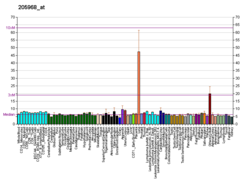| KCNS3 | |||||||||||||||||||||||||||||||||||||||||||||||||||
|---|---|---|---|---|---|---|---|---|---|---|---|---|---|---|---|---|---|---|---|---|---|---|---|---|---|---|---|---|---|---|---|---|---|---|---|---|---|---|---|---|---|---|---|---|---|---|---|---|---|---|---|
| Identifiers | |||||||||||||||||||||||||||||||||||||||||||||||||||
| Aliases | KCNS3 , KV9.3, potassium voltage-gated channel modifier subfamily S member 3 | ||||||||||||||||||||||||||||||||||||||||||||||||||
| External IDs | OMIM: 603888; MGI: 1098804; HomoloGene: 20518; GeneCards: KCNS3; OMA:KCNS3 - orthologs | ||||||||||||||||||||||||||||||||||||||||||||||||||
| |||||||||||||||||||||||||||||||||||||||||||||||||||
| |||||||||||||||||||||||||||||||||||||||||||||||||||
| |||||||||||||||||||||||||||||||||||||||||||||||||||
| |||||||||||||||||||||||||||||||||||||||||||||||||||
| |||||||||||||||||||||||||||||||||||||||||||||||||||
| Wikidata | |||||||||||||||||||||||||||||||||||||||||||||||||||
| |||||||||||||||||||||||||||||||||||||||||||||||||||
Potassium voltage-gated channel subfamily S member 3 (Kv9.3) is a protein that in humans is encoded by the KCNS3 gene. [5] [6] [7] KCNS3 gene belongs to the S subfamily of the potassium channel family. [7] It is highly expressed in pulmonary artery myocytes, [8] [9] [10] placenta, [11] and parvalbumin-containing GABA neurons in brain cortex. [12] [13] In humans, single-nucleotide polymorphisms of the KCNS3 gene are associated with airway hyperresponsiveness, [14] whereas decreased KCNS3 mRNA expression is found in the prefrontal cortex of patients with schizophrenia. [13]




